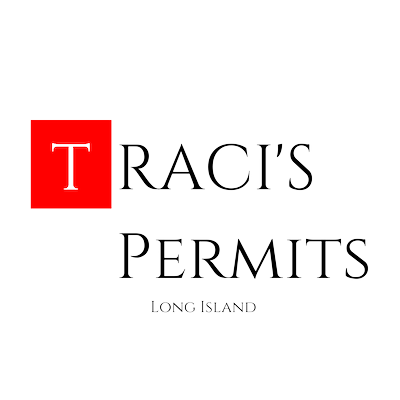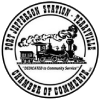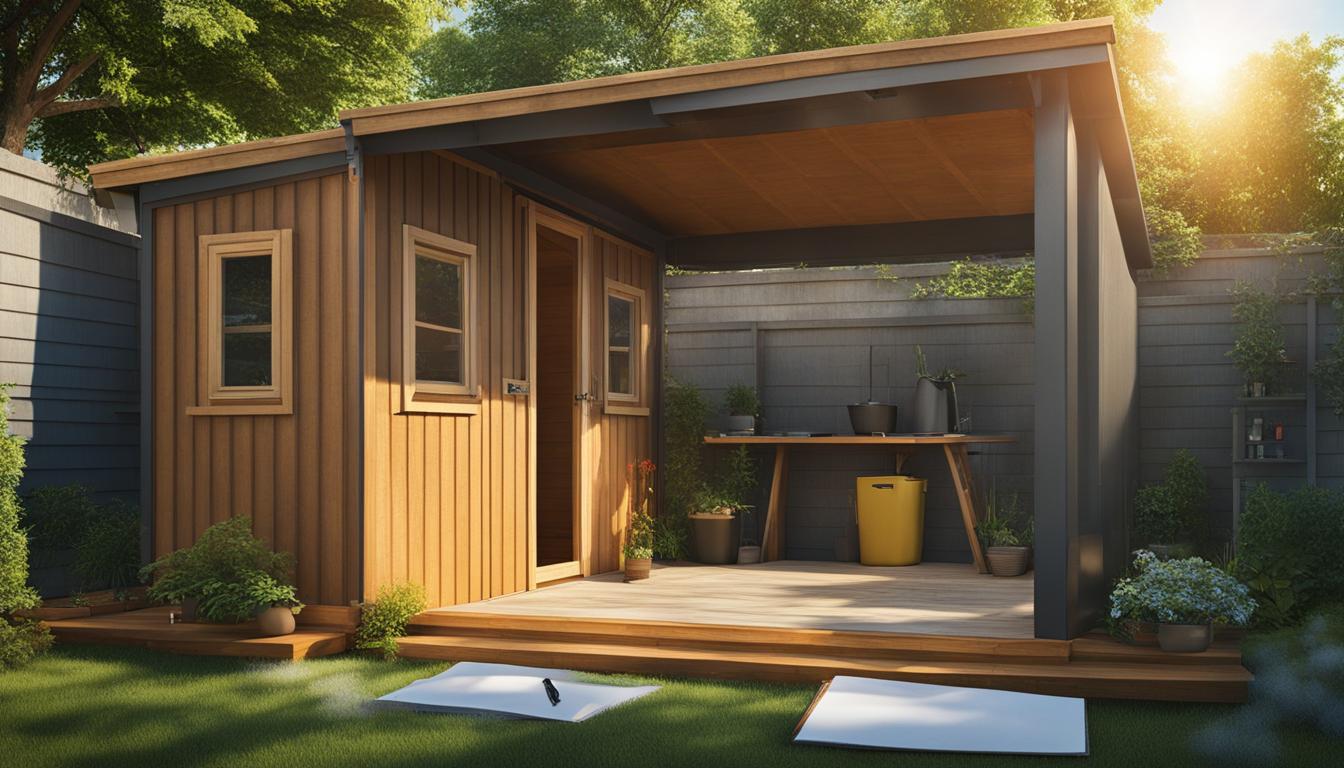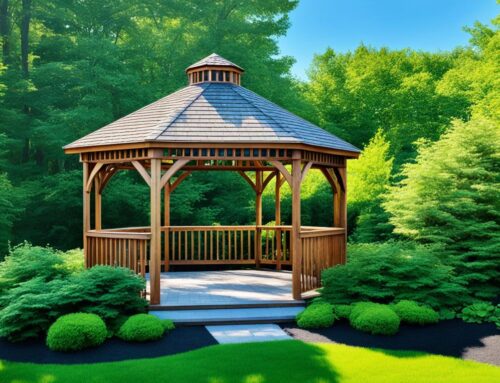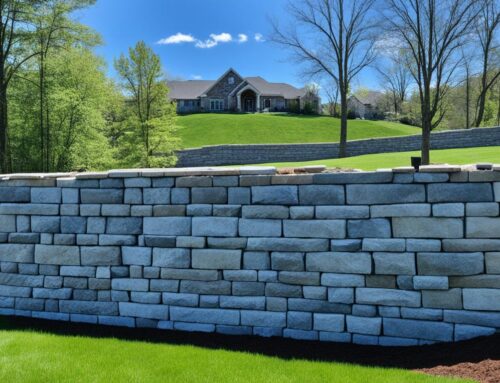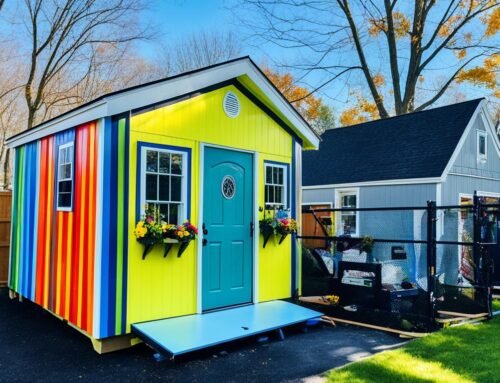Traci’s Permits offers unmatched expertise with Long Island’s permit process. We understand the importance of timely approvals and code compliance for hassle-free construction. Trust us to navigate the complexities of shed permits and ensure a smooth permit journey.
Building a shed can provide valuable storage space or a dedicated workspace. However, before you start your project, it’s crucial to determine whether you need a permit for your shed. Various factors influence permit requirements, such as shed size, location, purpose, building codes, HOA rules, setbacks, severe weather conditions, and the inclusion of electricity and plumbing.
Key Takeaways:
- Shed permits are influenced by factors such as size, location, purpose, building codes, HOA rules, setbacks, and inclusion of electricity and plumbing.
- Consult your local government or zoning department to determine the specific permit requirements for sheds in your area.
- Complying with building codes and HOA regulations is crucial to ensure permit approval and a successful project.
- Obtaining a permit for pre-built sheds is just as important as for on-site construction.
- Traci’s Permits offers expert assistance for a smooth and timely permit process. Call: 631-492-0927
Factors That Determine if You Need a Permit for Your Shed
When it comes to determining whether you need a permit for your shed, several key factors come into play. Understanding these factors will help you navigate the shed permit process with ease and ensure compliance with shed permit regulations.
Size of the Shed
The size of your shed is an important consideration when determining if a permit is required. Different jurisdictions have different regulations, but in general, sheds smaller than 120 square feet (sometimes 100 square feet) may not require a building permit. Larger sheds may have restrictions or require permits. Check with your local government to find out the permitted size limits for sheds in your area.
Location on Your Property
The location of your shed on your property is another factor that can influence whether a permit is necessary. Certain regulations may dictate setbacks from property lines, fences, trees, or other structures in your yard. It’s important to adhere to these regulations to determine if a shed permit is required.
Intended Purpose of the Shed
The purpose for which you plan to use your shed can also impact whether a permit is needed. If you’re using the shed for storage or as a gardening shed, a permit may not be required. However, if you intend to use the shed as an office, guest room, or small business space, a permit will likely be necessary. In some cases, additional zoning permits may also be required for business-related activities in your shed.
Adherence to Building Codes
Building codes play a crucial role in shed permit regulations. It is important to familiarize yourself with the building codes specific to your area, as they provide the foundation for permit requirements. Building codes ensure the safety and structural integrity of the shed and must be followed to obtain a permit.
Compliance with HOA Rules
If you live in a Homeowners Association (HOA) community, it is essential to consult your HOA guidelines regarding shed construction. HOA rules may have specific restrictions on shed size, location, and aesthetics. It is important to review and comply with these regulations to determine the permit requirements for your shed project.
Considerations for Severe Weather Conditions
Severe weather conditions, such as hurricanes or high wind areas, may require additional permit regulations for sheds. These regulations aim to ensure that the shed is structurally sound and can withstand the forces of nature. Be sure to check with your local government to determine if any specific permit requirements apply to your location.
Inclusion of Electricity and Plumbing
If your shed will include electricity or plumbing, additional permits are likely to be required. These permits ensure that the electrical and plumbing systems meet the necessary safety standards and are installed correctly. Check with your local building department to determine the specific requirements for obtaining these permits.
By considering these factors – shed size, location, intended purpose, adherence to building codes, compliance with HOA rules, setbacks, severe weather conditions, and inclusion of electricity and plumbing – you can determine the shed permit requirements for your project. Remember to consult with your local zoning department for detailed shed permit regulations and guidelines specific to your area.
Shed Permit Requirements Based on Size
The size of your shed can play a significant role in determining whether a permit is required. In many jurisdictions, sheds smaller than 120 square feet (or sometimes 100 square feet) do not require a building permit. However, larger sheds may have restrictions or require permits. Additionally, some areas have specific restrictions on the maximum size of sheds that are allowed. It is important to check with your local government to determine the permitted size for sheds in your area.
Traci’s Permits offers unmatched expertise with Long Island permit process. We ensure timely approvals and code compliance for hassle-free construction. For expert permit assistance, Call: 631-492-0927. Trust us for a smooth permit journey.
Shed Permit Restrictions by Size:
| Shed Size | Permit Requirement |
|---|---|
| Less than 100-120 sq. ft. | No permit required |
| 100-120 sq. ft. and larger | May have restrictions or require permit |
| Specific maximum size restrictions | Varies by location |
Shed Permit Guidelines for Location and Placement
When it comes to building a shed on your property, the location and placement of the structure play a significant role in determining whether you need a permit. Local shed permit regulations often have specific guidelines regarding setbacks, distance from other structures, property lines, trees, fences, and even the main house. To ensure compliance and determine if a permit is necessary for your shed construction, it is crucial to adhere to these shed permit guidelines.
In many areas, sheds cannot be attached to or located in close proximity to the house, trees, fences, property lines, or other structures within the yard. These regulations aim to maintain proper spacing and prevent potential hazards or property disputes. By maintaining appropriate distances, you not only comply with building codes but also ensure the safety and functionality of your shed.
Check with your local zoning department to understand the specific guidelines for your area. They can provide you with the necessary information on setbacks and placement restrictions that apply to shed construction permits.
Understanding Setbacks
Setbacks refer to the minimum distance required between your shed and various elements in your yard, such as property lines, fences, or your main house. These setbacks are in place to ensure the safety and well-being of your property and those around you. Violating setbacks can lead to legal issues and costly fines.
The required setbacks may vary depending on your location and the size of your shed. For example, a shed that has plumbing or electrical components may require greater setbacks compared to a simple storage shed without these utilities. It is important to consult your local zoning regulations to determine the specific setback requirements for your shed permit.
Benefits of Adhering to Shed Permit Guidelines
Adhering to shed permit guidelines benefits you in several ways:
- Compliance: By following the shed permit regulations, you ensure compliance with local building codes, minimizing the risk of penalties or legal issues down the line.
- Safety: Proper placement and spacing of your shed help maintain a safe environment, preventing accidents or damage to your property.
- Neighbor Relations: Respecting setbacks and other placement guidelines can help maintain positive relationships with your neighbors, avoiding disputes over property boundaries.
Understanding and following shed permit guidelines for location and placement is essential to ensure a smooth and hassle-free shed construction process, while also abiding by local regulations. By taking the necessary steps to comply with these guidelines, you can enjoy your new shed with peace of mind.
| Benefits of Adhering to Shed Permit Guidelines | Compliance | Safety | Neighbor Relations |
|---|---|---|---|
| ✔️ | ✔️ | ✔️ |
Shed Permit Requirements for Intended Use
The intended use of your shed can determine whether a permit is needed. In some cases, if you plan to use the shed solely for storage or as a gardening shed, a permit may not be required.
However,
if you intend to use the shed as an office, guest room, or small business space, a permit will likely be necessary.
In addition to the shed permit application, you may also need to obtain additional zoning permits for certain business-related activities conducted in your shed. It is important to research and comply with all regulations pertaining to your intended use to ensure a smooth permit process.
| Intended Use | Permit Required |
|---|---|
| Storage | No |
| Gardening shed | No |
| Office | Yes |
| Guest room | Yes |
| Small business space | Yes |
Before proceeding with your shed construction, ensure you understand the specific permit requirements associated with your intended use. Contact your local zoning department for more information and clarity on the shed permit process.
Traci’s Permits offers unmatched expertise with the Long Island shed permit process. We ensure timely approvals and code compliance for hassle-free construction. For expert permit assistance, call 631-492-0927. Trust us for a smooth permit journey.
Building Codes and Shed Permit Regulations
When it comes to shed permit regulations, building codes are a crucial factor to consider. The International Building Codes (IBC) provide the foundation for building regulations, but it’s important to note that local amendments and laws may impose stricter requirements. To ensure compliance and determine the necessary permit requirements for your shed construction, you need to familiarize yourself with the building codes and regulations specific to your county, city, and state.
By adhering to these guidelines, you can ensure that your shed project meets all necessary safety and structural requirements. Building codes are in place to protect the well-being of occupants and ensure that buildings are constructed to withstand various conditions, such as severe weather events. It is your responsibility as a shed owner to ensure that your construction adheres to these codes.
When applying for a shed permit, you may be required to provide documentation that demonstrates compliance with the relevant building codes. This documentation may include detailed plans, engineering calculations, or other supporting materials that prove the structural integrity and safety of your shed.
Understanding Local Building Codes
Each county, city, and state may have its own set of building codes and regulations that apply to shed construction. It is essential to familiarize yourself with these guidelines before beginning your shed project. Here are some key aspects that building codes may cover:
- Minimum requirements for foundation and structural support
- Minimum and maximum dimensions for sheds
- Fire safety regulations, including materials used and proximity to other structures
- Electrical and plumbing requirements, if applicable
- Accessibility guidelines for sheds used as living or working spaces
- Severe weather considerations, such as hurricane or earthquake resistance
Ensuring compliance with these building codes is essential not only to obtain a shed permit but also to guarantee the safety and durability of your shed. By following the correct guidelines and documentation, you can proceed confidently with your shed construction project.
Traci’s Permits: Your Expert Guide
“Traci’s Permits offers unmatched expertise with Long Island’s permit process. We ensure timely approvals and code compliance for hassle-free construction.”
For expert permit assistance, Call: 631-492-0927. Trust us for a smooth permit journey.”
| Key Takeaways | Benefits |
|---|---|
| Understanding building codes is crucial for shed permit compliance. | • Ensures safety and structural integrity • Prevents fines and penalties • Peace of mind knowing your shed meets regulations |
| Local building codes may have specific requirements for shed construction. | • Varied restrictions on shed dimensions • Fire safety and material regulations • Accessibility guidelines for sheds used as living or working spaces |
| Compliance with building codes may require documentation. | • Detailed shed plans and engineering calculations • Materials specifications • Safety certifications |
Shed Permit Considerations for HOA Communities
If you reside in a Homeowners Association (HOA) community, it is important to consult your HOA guidelines regarding shed construction. HOA rules may have specific restrictions on shed size, aesthetic guidelines, and location, such as the distance from property lines. It is essential to review and comply with these regulations to determine the permit requirements for your shed project.
In many HOA communities, shed permit restrictions are in place to maintain the visual appeal and uniformity of the neighborhood. These restrictions may include limitations on the height, color, design, and materials used for the shed. HOAs often have architectural committees or design review boards that oversee shed construction to ensure compliance with their guidelines.
Additionally, HOAs may have regulations regarding the placement and location of sheds. They may require sheds to be positioned in specific areas of the property or set back a certain distance from property lines or other structures. These requirements help preserve property values and ensure a cohesive and organized community appearance.
Understanding and complying with these shed permit regulations in HOA communities is crucial to avoid any penalties or disputes with your homeowners association. It is recommended to thoroughly review the HOA guidelines and consult with the appropriate individuals or committees to ensure that your shed construction project meets all necessary requirements.
Shed Permit Process and Application
The process of obtaining a shed permit involves several essential steps that ensure a smooth and timely approval for your shed construction. By following these procedures diligently, you can navigate the permit application process with ease.
- Complete the permit application: Start by filling out the shed permit application form provided by your local zoning department. This application typically requires information about the shed’s size, dimensions, materials, and intended use.
- Pay the necessary fees: Along with the application, you will need to submit the required permit fees. The fees vary depending on your location and the size of your shed. Be sure to check with your local zoning department for the specific fee amount and payment methods.
- Provide a plot plan or site plan: Include a detailed plot plan or site plan of your property that highlights the location and placement of your shed. This plan should indicate setbacks from property lines, other structures, and any relevant features such as trees or fences.
- Submit the necessary documentation: In addition to the application and site plan, you may be required to provide additional documentation. This can include construction drawings, structural calculations, and proof of compliance with building codes and regulations. Check with your local zoning department for the specific documentation requirements.
Quote: Expert Permit Assistance for a Smooth Journey
Traci’s Permits offers unmatched expertise with Long Island’s shed permit process. With our in-depth knowledge and experience, we ensure timely approvals and code compliance for hassle-free shed construction. Trust us to handle your permit application with precision and efficiency. For expert permit assistance, call us at 631-492-0927. Let us guide you through a smooth permit journey.
Remember, the exact requirements and procedures for obtaining a shed permit may vary depending on your local zoning department. It’s important to consult with them to ensure you fulfill all the necessary requirements. By following the shed permit process and submitting a complete application, you can expedite the approval process and begin your shed construction project on schedule.
Shed Permit for Pre-Built Sheds
When it comes to permit requirements, pre-built sheds are treated no differently than sheds constructed on-site. It is crucial to obtain the necessary permit before purchasing and installing a pre-built shed to ensure compliance with local regulations and avoid potential penalties.
Some shed installation companies may even request proof of a valid building permit before proceeding with the installation. By obtaining the permit beforehand, you can ensure a hassle-free shed building process and avoid delays or legal complications.
Traci’s Permits specializes in permit applications and approvals for residents of Long Island. Our team of experts has the knowledge and experience to guide you through the permit process, ensuring timely approvals and code compliance for a smooth construction journey. For expert permit assistance, contact Traci’s Permits at 631-492-0927.
| Benefits of Obtaining a Shed Permit for Pre-Built Sheds: |
|---|
| 1. Compliance with local regulations and building codes. |
| 2. Avoidance of potential fines or legal complications. |
| 3. Assurance of a smooth and hassle-free shed building process. |
| 4. Confidence in the structural integrity and safety of the shed. |
| 5. Possibility of insurance coverage in case of damage or accidents. |
| 6. Compliance with HOA guidelines and restrictions, if applicable. |
Traci’s Permits offers unmatched expertise with Long Island permit process. We ensure timely approvals and code compliance for hassle-free construction. Trust us for a smooth permit journey.
Conclusion
Building a shed is an exciting project that can add valuable storage space or a dedicated workspace to your property. However, it’s crucial to understand the shed permit requirements for your specific circumstances to ensure a smooth and successful construction process.
Factors such as the size of the shed, its location, intended use, adherence to building codes, HOA rules, setbacks, severe weather considerations, and the inclusion of electricity and plumbing can all determine whether a permit is required for your shed.
By familiarizing yourself with these shed permit guidelines and following the necessary permit application process, you can ensure code compliance and avoid unnecessary delays or fines. Consulting with your local zoning department is essential for obtaining specific guidelines and regulations applicable to your area.
Traci’s Permits offers unmatched expertise in navigating the Long Island permit process. With our assistance, you can trust that your permit journey will be hassle-free, ensuring timely approvals and code compliance. For expert permit assistance, contact Traci’s Permits at 631-492-0927 and experience a smooth permit journey.
FAQ
Do I need a permit for my shed?
The need for a permit depends on several factors, including the size, location, intended use, and adherence to building codes and HOA rules. It is important to check with your local government to determine the permit requirements for your shed construction.
What factors determine if I need a permit for my shed?
Factors that influence the need for a permit include shed size, location on your property, intended purpose, building codes, HOA rules, setbacks, severe weather considerations, and inclusion of electricity and plumbing.
What are the shed permit requirements based on size?
In many jurisdictions, sheds smaller than a certain square footage (varies by location) do not require a permit. Larger sheds may have restrictions or require permits, and specific limitations on shed size may apply. Check with your local government for permitted shed sizes in your area.
What are the shed permit guidelines for location and placement?
Sheds cannot be attached to or located too close to other structures, houses, fences, trees, property lines, or in violation of specific setback regulations. Adhering to these guidelines will help determine if a permit is necessary for your shed.
What are the shed permit requirements for intended use?
If your shed will be used solely for storage or gardening, a permit may not be required. However, if it will be used as an office, guest room, or small business space, a permit will likely be necessary. Additional zoning permits may also be required for business-related activities.
How do building codes influence shed permit regulations?
Building codes laid out by the International Building Codes (IBC) provide the foundation for shed construction regulations. Local amendments and laws may impose stricter requirements. Familiarize yourself with the building codes and regulations specific to your area to ensure compliance and determine permit requirements.
What shed permit considerations apply to HOA communities?
If you reside in a Homeowners Association (HOA) community, consult your HOA guidelines regarding shed construction. HOA rules may have restrictions on shed size, aesthetics, and location. Review and comply with these regulations to determine permit requirements.
What is the shed permit process and application?
The shed permit process typically involves completing an application, paying fees, providing a plot plan or site plan, and submitting necessary documentation. Specific requirements and procedures may vary by jurisdiction. Follow these steps to ensure a smooth and timely permit approval process.
Do pre-built sheds require a permit?
Yes, the same permit requirements apply to pre-built sheds as to sheds constructed on-site. Obtain the necessary permit before purchasing and installing a pre-built shed. Some installation companies may require proof of a building permit for installation.
What do I need to know about shed permit requirements?
Shed permit requirements are determined by factors such as shed size, location, intended use, building codes, HOA rules, setbacks, severe weather considerations, and inclusion of electricity and plumbing. Familiarize yourself with these requirements, follow the necessary permit application process, and consult with your local zoning department for specific guidelines and regulations applicable to your area.
